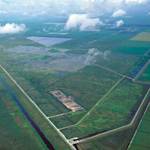The Pantanal, The world’s largest tropical wetland
2023 CE • South America
"Situated in the heart of South America, the Pantanal is the world’s largest tropical wetland. At 42 million acres, the Pantanal covers an area slightly larger than England and sprawls across three countries—Bolivia, Brazil, and Paraguay. While not as globally familiar as the Amazon to the north, the Pantanal is one of the most biologically rich environments on the planet with more than 4,700 plant and animal species. In fact, the Pantanal contains South America’s highest concentration of some wildlife species, including the jaguar and caiman . . . Currently, the Pantanal remains relatively intact. However, a growing number of environmental pressures, ranging from unsustainable infrastructure development to untreated waste pollution, threaten to destabilize the regional ecosystem and the benefits it provides people and wildlife. Deforestation in the Pantanal is increasing, with more than 12% of the forest cover already lost. At the current rate, the Pantanal’s native vegetation will disappear by 2050 if no measures are taken to combat this trend."
"The Pantanal: Saving the world’s largest tropical wetland," World Wildlife Foundation.
Image: Filipefrazao, CC BY-SA 3.0, via Wikimedia Commons


Learn about Maya Lin’s fifth and final memorial: a multi-platform science based artwork that presents an ecological history of our world - past, present, and future.

Discover ecological histories and stories of former abundance, loss, and recovery on the map of memory.

Learn how we can reduce our emissions and protect and restore species and habitats – around the world.

See how art can help us rethink the problems we face, and give us hope that each one of us can make a difference.

Help make a global memorial something personal and close to home. Share your stories of the natural world.


